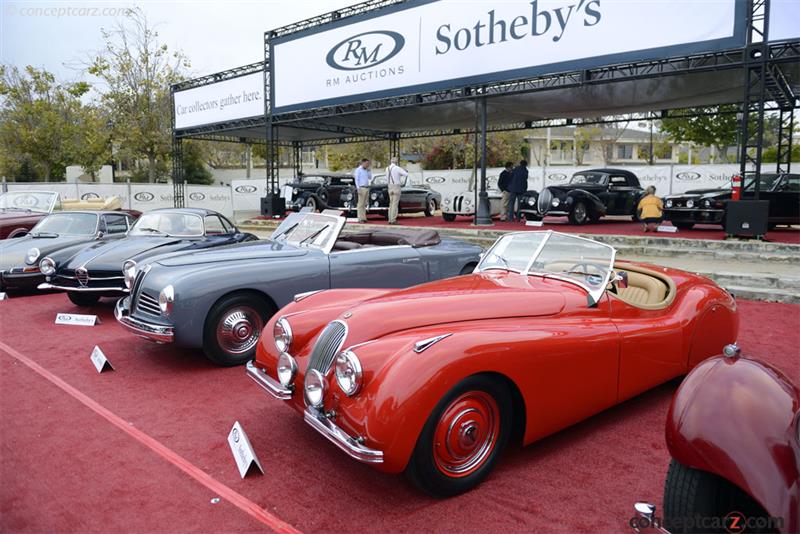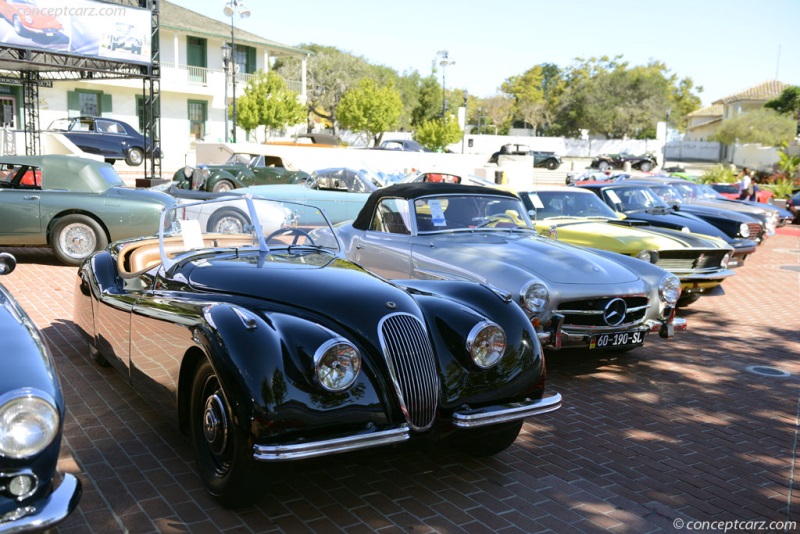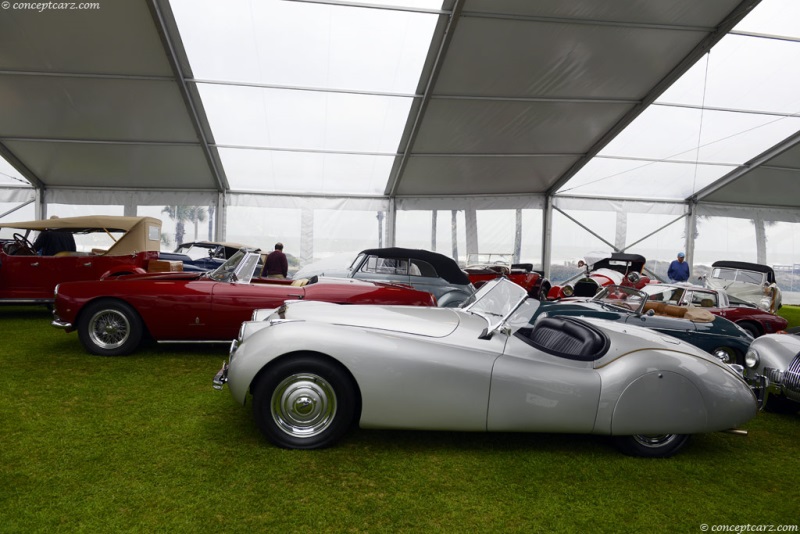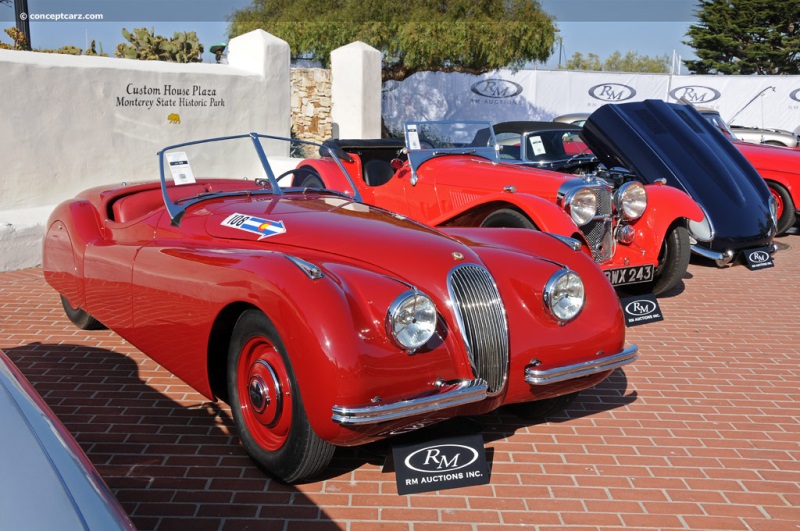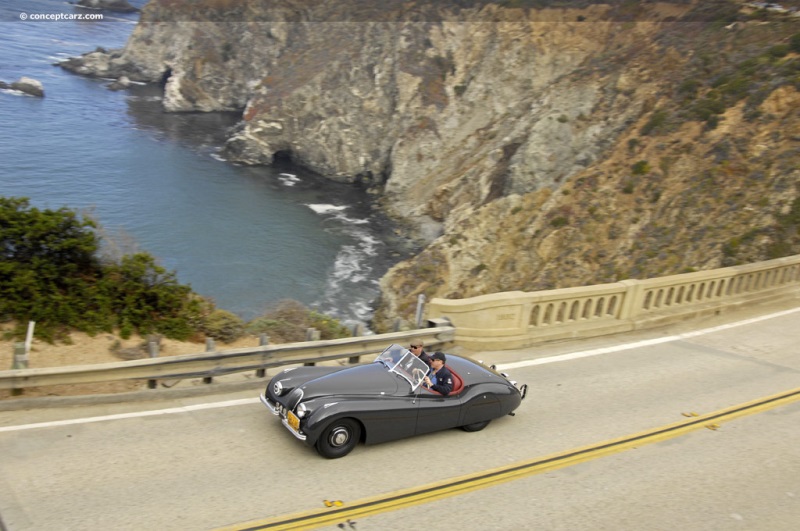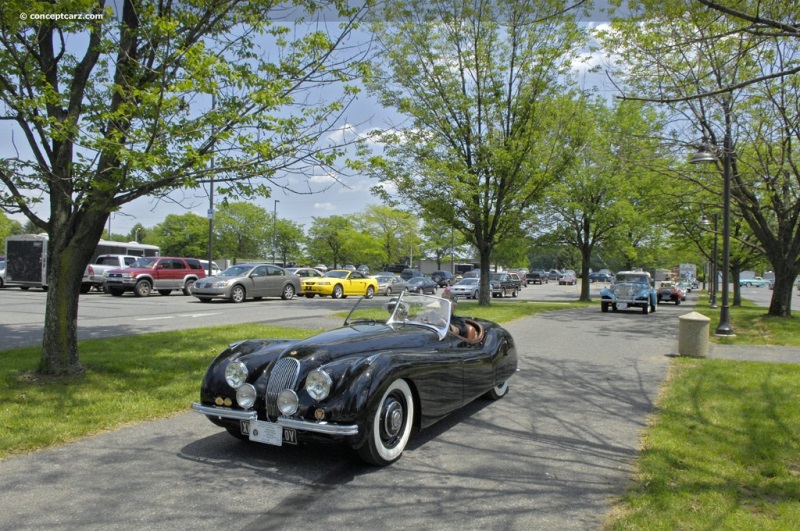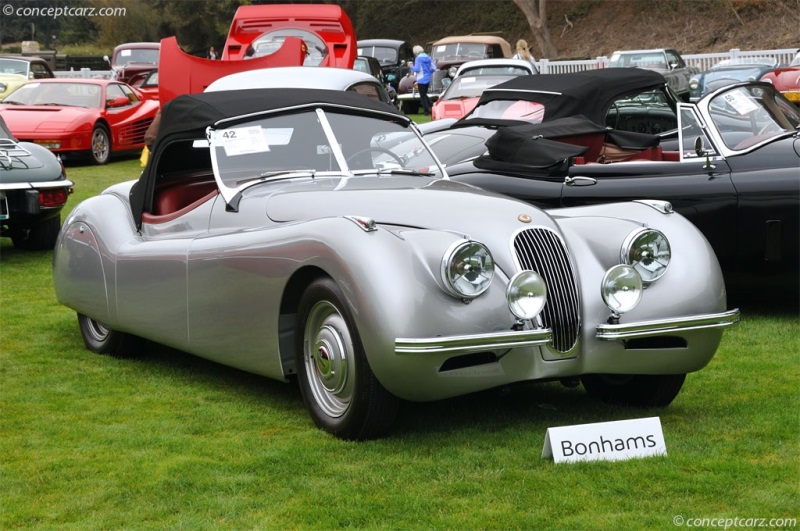In October of 1948, at the Earls Court Motor Show in London, Britain witnessed the emergence of the Jaguar XK120. It was a show-piece car for the Jaguar name and intended to be produced in low volume as a 'specialty car'. Initially dubbed the XK Open Two Seater Super Sport, it was quickly changed to the XK 120 to capitalize on the vehicle's top speed - 120 miles per hour. The 'X' represented the 'experimental' engine type while the letter 'K' was the sequence. 
Roadster
View info and historyWilliam Lyons, the creator and owner of the Jaguar Cars Ltd. Company, had commissioned the chief engineer William Heynes to develop a modern sedan that could endure the post-war marketplace. What was designed and coupled to a six-cylinder dual overhead cam engine was truly a masterpiece that has stood the test of time. The 120 mile-per-hour fact was important; it made it the fastest standard production car in the world (it was even faster when the windscreen was removed). The success of this aluminum-bodied vehicle was based on its performance, styling, and value. Priced very affordably, it was often much less than the competition. The problem was that the XK 120 was intended to be produced in low volume. The very early models featured an aluminum body. After the introduction, the demand for the vehicle was overwhelming. The body material was changed to metal so it could be produced on a production line, thus eliminating the need for the slow process of hand-building each vehicle. Two-hundred and forty-two open two-seater examples were produced with wooden frames and aluminum shells. Most, except five or six models, were exported. The metal body was nearly identical to the aluminum except for some hard-to-spot panels that had minor differences in the curvature. The all-steel bodies introduced in early 1950 were approximately 112 lbs heavier than the aluminum bodies.Mechanical Specification
The XK 120 featured a 3442 cc 6-cylinder engine producing 160 horsepower at 5,000 RPM. The XK 120 SE produced 180 horsepower, while the XK 120M produced 210. Hydraulic drum brakes were fitted on all four tires. A four-speed manual gearbox was standard while the SE models received Overdrive to increase the performance. The front suspension was independent with a live rear axle. After 1951, a heater was included as standard equipment.
Roadster
View info and historyThe Jaguar XK120 rested on a 102-inch wheelbase, had an overall length of 173 inches, was 61.5 inches wide, and 52.5 inches tall.The 1948 London Motor Show
At the 1948 London Motor Show, Jaguar displayed the first prototype, chassis number 660001. Fitted with the new Jaguar XK engine designed by Jaguar Chief Engineer William Heynes, its exterior styling was similar to the production cars that would soon follow. Only minor differences distinguished the prototype from the production cars, including the straight outer pillars of its windscreen, while the production examples had curved pillars.The first production XK120, chassis number 670003, was delivered to Clark Gable.Competition, Rallying, and Performance
Roadster
Chassis #: 670005
View info and history
Auction entries : 3The XK 120 was durable. In 1952 an XK 120 coupe was driven on a track in Montlhery, France, by a team of racing drivers including Stirling Moss. For seven days and night, the vehicle was driven constantly. At the completion of the week, it had traveled over 16,860 miles and averaged 100 mph. In 1951, the XK 120 was entered in the grueling 24-hour of Le Mans race. Three vehicles were purpose-built and dubbed the XK 120C model. The 'C' represented 'competition. This would be the first of five Jaguar victories at Le Mans in seven years. A Jaguar XK 120C won the event while averaging 93.49 miles per hour. In the United States, Jaguar and MG are credited with jump-starting the American Sports Car market after World War II. Chevrolet would later answer with their Corvette. It was the sensual styling and performance of the British cars that stimulated the desires of the American public. Road & Track magazine performed independent testing and found the vehicle capable of 121.6 mph and a zero-to-sixty time of 10.1 seconds. It was claimed by many as the greatest touring car in the world.Production
The XK 120 was produced from 1949 through 1954, when it was replaced with the XK 140. During its life span, 7,630 roadsters, 2,678 coupes and 1,769 convertibles were produced. Roadsters were dubbed 'OTS' or Open Top Sportsters. The 'DHC' meant 'Drop Head Coupe' while 'FHC' represented 'Fixed Head Coupe.
by Daniel Vaughan | Jun 2008

Roadster
View info and history
The XK 120 featured a 3442 cc 6-cylinder engine producing 160 horsepower at 5,000 RPM. The XK 120 SE produced 180 horsepower, while the XK 120M produced 210. Hydraulic drum brakes were fitted on all four tires. A four-speed manual gearbox was standard while the SE models received Overdrive to increase the performance. The front suspension was independent with a live rear axle. After 1951, a heater was included as standard equipment.
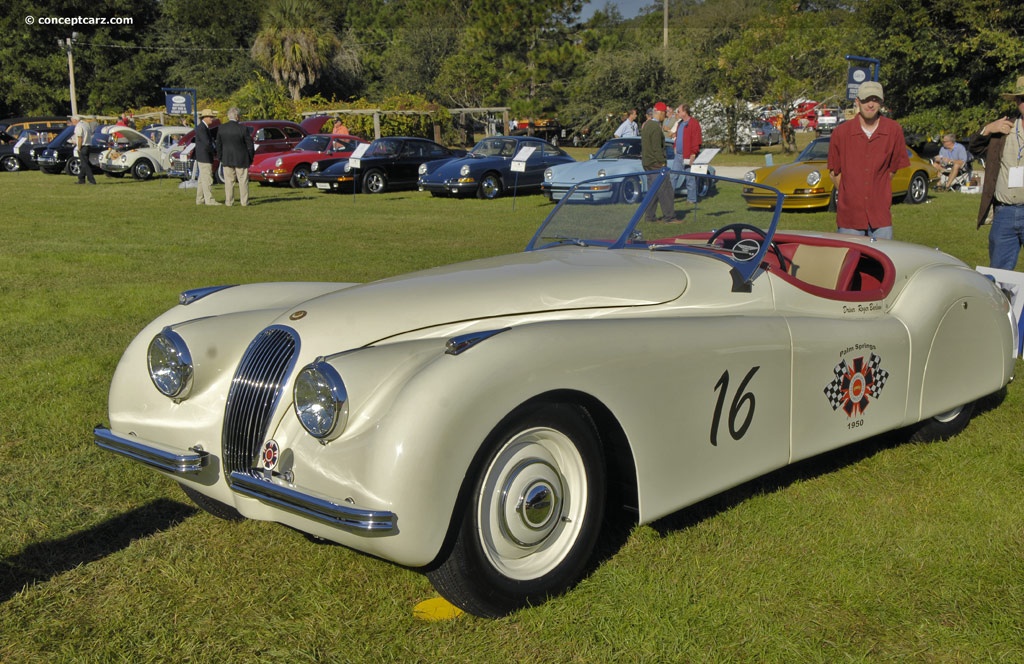
Roadster
View info and history
At the 1948 London Motor Show, Jaguar displayed the first prototype, chassis number 660001. Fitted with the new Jaguar XK engine designed by Jaguar Chief Engineer William Heynes, its exterior styling was similar to the production cars that would soon follow. Only minor differences distinguished the prototype from the production cars, including the straight outer pillars of its windscreen, while the production examples had curved pillars.The first production XK120, chassis number 670003, was delivered to Clark Gable.Competition, Rallying, and Performance
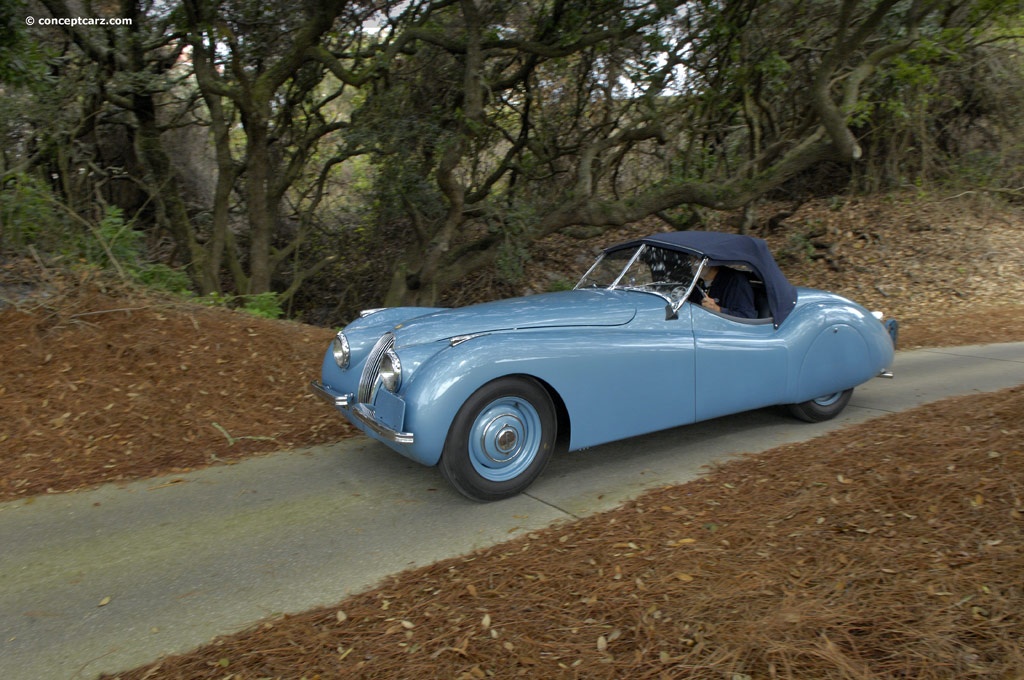
Roadster
Chassis #: 670005
View info and history
Auction entries : 3
The XK 120 was produced from 1949 through 1954, when it was replaced with the XK 140. During its life span, 7,630 roadsters, 2,678 coupes and 1,769 convertibles were produced. Roadsters were dubbed 'OTS' or Open Top Sportsters. The 'DHC' meant 'Drop Head Coupe' while 'FHC' represented 'Fixed Head Coupe.
by Daniel Vaughan | Jun 2008
This year marks the 75th anniversary of the Jaguar name, and 75 years of looking forward, designing and building cars that represent the very best of technical innovation, design leadership and sporting success.
Roadster
View info and historyMike O'Driscoll, Managing Director of Jaguar Cars, said: 'In 2010 we celebrate our past, and 75 years of designing and building cars that celebrate the art of automobile making. We're also celebrating the promise of the future, and the introduction of the all-new XJ. In just three years we've completely revitalized the Jaguar line-up with the launch of three beautiful fast cars'.Just a few years ago Jaguar set out to re-make the brand and to revitalize the model range. It started in 2008 with the introduction of the all-new award-winning XF. This four door, five seat car has the looks of a coupe and the heart of a sports car. In 2009 Jaguar re-engineered the XK coupe and convertible, and in the process created one of the world's great grand tourers. And, 2010 sees the beginning of sales of the ground-breaking XJ, which incorporates all of the virtues that make a Jaguar.Mike O'Driscoll added: 'The development of our new range of cars is all part of making Jaguar the modern, sporting company that it was under our founder Sir Williams Lyons – a company that made its name creating cars that were innovative, exciting and always original.'
Roadster
View info and historyIan Callum, Jaguar Design Director, said: 'Jaguar design over the next 75 years must respect and reflect on the past 75 while continuing to push boundaries of technology, luxury and sporting style. Designing cars with a presence that demands a turn of the head and an allure that pulls at the heart has been central to the Jaguar brand throughout the years. 'A successful piece of design should stand the test of time, holding it's own through passing fashions. Jaguar has a range of cars that are as iconic today as they were when launched – testament to Jaguar's legacy in creating beautiful fast cars. 'Looking at the present with the XK, XF and all-new XJ and with an eye on the future, we will continue to innovate and set the benchmark, not only in automotive design, but in luxury premium design as a whole.'
Roadster
Chassis #: 670005
View info and history
Auction entries : 3Sir William Lyons founded Swallow Sidecars in 1922, and went on to create a range of 'SS' branded motorcycle sidecars and automobiles in the 1920s and early 1930s. When it came to the launch of the all-new SS 100 in 1935, Sir William wanted a new and evocative name for his company. After asking his advertising agency for suggestions, Sir William chose 'Jaguar', and the SS 100 model became the world's first Jaguar.The ‘Jaguar' name was an ideal choice - it represented the feline grace and elegance, power and agility that set his cars apart. Sir William once said that a car 'was the closest thing we can create to something that is alive', a sentiment that has stood the test of time. The new brand name captured the essence of all of the cars created from that point forward. Over the years Jaguar has built some of the world's most iconic cars; the XK120, introduced in the late 1940s, was an instant sensation and the most glamorous sports car of the period; the C Type and D Type race cars that followed, dominated motor racing in the 1950s; the E-Type, launched in the heady 1960s, has been called the most beautiful car ever built and it defined a whole generation. Sports cars have always defined Jaguar, but the Company has also built some of the Industry's most memorable sedans, such as the Mark II in the early 1960's and the renowned XJ range.
Roadster
Chassis #: 146
View info and historyDuring the year Jaguar will celebrate our 75th anniversary at some of the world's most glamorous automotive settings, including the Goodwood Festival of Speed and Revival in the UK; the Concours D'Elegance at Pebble Beach in the US and at the Mille Miglia classic in Italy. Jaguar is also returning to the racetrack with its new JaguarRSR XKR GT2 and will compete in the American Le Mans Series (ALMS).Source - Jaguar

Roadster
View info and history

Roadster
View info and history

Roadster
Chassis #: 670005
View info and history
Auction entries : 3
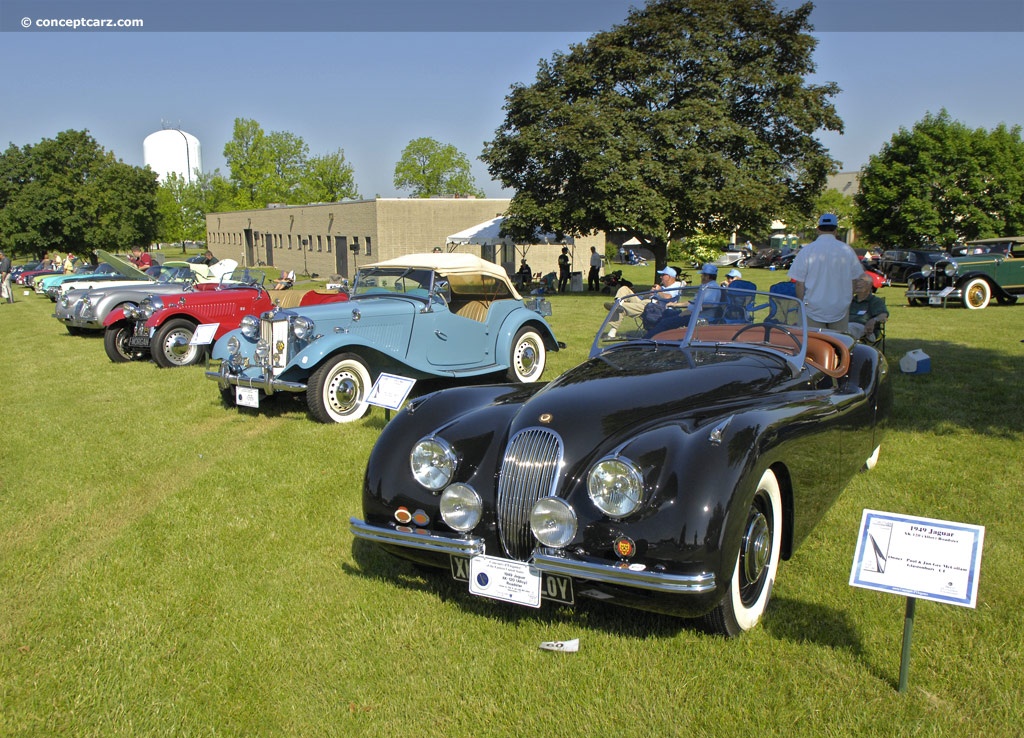
Roadster
Chassis #: 146
View info and history
Related Reading : Jaguar XK120 History
The Jaguar XK120 was designed to be a prestigious vehicle and produced in low numbers. The designation 120 represented the vehicles top speed of 120 miles-per-hour. At the time, it was the fastest production car in the world. The British automotive industry was greatly influenced by World War II. Many manufacturers went out of business due to the lack of funds, fuel and supply shortages, or....
Continue Reading >>
Continue Reading >>
Similar Automakers
Similarly Sized Vehicles
from 1949
Similarly Priced Vehicles
- Lincoln Cosmopolitan ($3,185-$3,945)
Average Auction Sale: $322,594
1949 Jaguar XK120 Vehicle Profiles
Recent Vehicle Additions
Performance and Specification Comparison
Price Comparison
$3,750 - $3,850
XK120 Specification Comparison by Year
Year
Production
Wheelbase
Engine
Prices
102.00 in.
6 cyl., 210.04 CID., 150.00hp
6 cyl., 210.04 CID., 160.00hp
6 cyl., 210.04 CID., 180.00hp
6 cyl., 210.04 CID., 160.00hp
6 cyl., 210.04 CID., 180.00hp
$3,855 - $4,000
Related Automotive News

A Comparison of 1997 Best of Show and 2022 Best of Show Nominee at the Pebble Beach Concours d'Elegance
Left 1997 Best of Show Right 2022 Best of Show Nominee
The combined efforts of Talbot-Lago and Figoni %26 Falaschi resulted in many wondrous automotive creations, including the T150C model with goutte deau, literally a drop...

Original Aston Martin DB4 GT Continuation Car, With Delivery Miles, Comes To Market Via Aston Martin Works
2 July 2020, Newport Pagnell, Buckinghamshire The hugely successful Aston Martin Continuation car programme, which started in 2017 with the DB4 GT Continuation, has set the standard for the creation of new-build heritage cars around the world.
With...

The Mid-Engine Corvette at the Amelia Island Concours d'Elegance
With the recent introduction of the Chevrolet C8 Corvette, the first production mid-engine Corvette sports car, the 2020 Amelia Island Concours dElegance took the opportunity to tell the story of the mid-engine Corvette legacy. The canvas...

RM Sotheby's Presents Highly Original Aston Martin DB3S Works at Monterey Auction
SECOND WORKS CAR, CAMPAIGNED BY MOTORSPORT HERO PETER COLLINS
DB3S WORKS JOINS LIST OF STUNNING MODELS THROUGH THE DECADES SET FOR AN EVENING WITH ASTON MARTIN ON 15 AUGUST
RM Sothebys offers highly original and matching numbers 1953...

Mercedes-Benz Pays Homage to a Regional Classic at the 2013 Greenwich Concours d'Elegance
The all-new 2014 E-Class Wagon Debuts Alongside a 1957 300c
Mercedes-Benz USA debuts the all-new 2014 E-Class Wagon alongside one of its predecessors, a pristine 1957 300c at the 18th Annual Greenwich Concours dElegance from June 1-2, 2013....



























